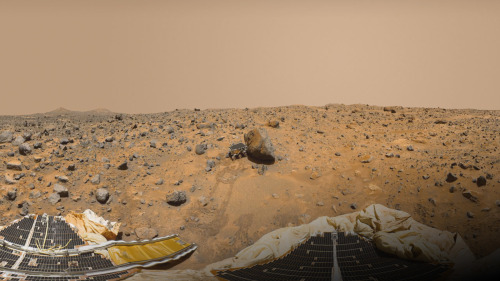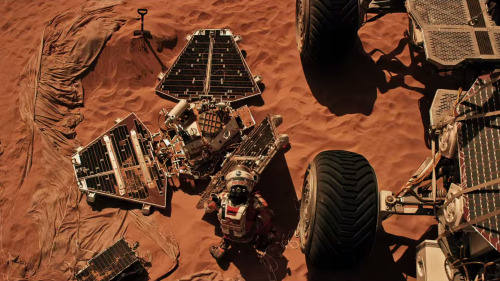Saturn Wip // Michael MacRae

Saturn Wip // Michael MacRae
More Posts from Darggga-blog and Others

Apollo 12 astronauts train for the Moon, September 1969.

Whisps of the Orion nebula
Source: https://imgur.com/t8ylC


Mars Pathfinder & Sojourner Rover (360 View) Explained
Thanks to new technology, we can take a 360-degree tour of the 1997 Pathfinder mission landing site, including Sojourner, the first Mars rover. Check out this interactive YouTube panorama, and then…
…keep scrolling to find out more about each point of interest, how the Pathfinder mission compares to “The Martian” and NASA’s real Journey to Mars.

Yogi
“Yogi” is a meter-size rock about 5 meters northwest of the Mars Pathfinder lander and the second rock visited by the Sojourner Rover’s alpha proton X-ray spectrometer (APXS) instrument. This mosaic shows super resolution techniques applied to help to address questions about the texture of this rock and what it might tell us about how it came to be.

Twin Peaks
The Twin Peaks are modest-size hills to the southwest of the Mars Pathfinder landing site. They were discovered on the first panoramas taken by the IMP camera on the July 4, 1997, and subsequently identified in Viking Orbiter images taken over 20 years ago. They’re about 30-35 meters tall.

Barnacle Bill
“Barnacle Bill” is a small rock immediately west-northwest of the Mars Pathfinder lander and was the first rock visited by the Sojourner Rover’s alpha proton X-ray spectrometer (APXS) instrument. If you have some old-school red-cyan glasses, put them on and see this pic in eye-popping 3-D.

Rock Garden
The Rock Garden is a cluster of large, angular rocks tilted in a downstream direction from ancient floods on Mars. The rocky surface is comprised of materials washed down from the highlands and deposited in this ancient outflow channel.

MOAR INFO
Pathfinder Lander & Sojourner Rover
Mission Facts [PDF]
Science Results
Rock & Soil Types


This vista was stitched together from many images taken in 1997 by Pathfinder.

Pathfinder and Sojourner figure into Mark Watney’s quest for survival on the Red Planet in the book and movie, “The Martian.” See JPL’s role in making “The Martian” a reality: http://go.nasa.gov/1McRrXw and discover nine real NASA technologies depicted in “The Martian”: http://go.nasa.gov/1QiyUiC.

So what about the real-life “Journey to Mars”? NASA is developing the capabilities needed to send humans to Mars in the 2030s. Discover more at http://nasa.gov/journeytomars and don’t forget to visit me when you make it to the Red Planet. Until then, stay curious and I’ll see you online.
The European Space Agency’s Sentinel-3 satellite, launched this week, is seen crossing the sky not long after launch with a jettisoned rocket stage right behind it, all amidst the beautiful northern lights display in northern Finland.
Breathtaking.

In memory of the crew of Apollo 1, January 27, 1967.

Infographic about Planet 9, the required planet to explain the trajectory of six of the most distand known Kuiper Belt Objects.
Source: http://imgur.com/S5faizX
https://m.facebook.com/story.php?story_fbid=10157485756070131&id=353851465130
Spacex's rocket landing. Again.
Animation visualising milestones during the launch of the ExoMars 2016 mission and its cruise to Mars.
The mission comprises the Trace Gas Orbiter and an entry, descent and landing demonstrator module, Schiaparelli, which are scheduled to be launched on a four-stage Proton-M/Breeze-M rocket from Baikonur during the 14–25 March 2016 window. About ten-and-a-half hours after launch, the spacecraft will separate from the rocket and deploy its solar wings. Two weeks later, its high-gain antenna will be deployed. After a seven-month cruise to Mars, Schiaparelli will separate from TGO on 16 October. Three days later it will enter the martian atmosphere, while TGO begins its entry into Mars orbit.
What’s Up for March 2016?
In March, Jupiter, it’s moons and moon shadows will all be visible in the sky. Find out when and where to look up:

Jupiter dominates the evening sky this month, rising at sunset and setting at dawn. On March 8, Jupiter reaches what is called “opposition”. Imagine that Jupiter and the sun are at opposite ends of a straight line, with the Earth in between. This brings Jupiter its closest to Earth, so it shines brighter and appears larger in telescopes.

On the nights of March 14 – 15, March 21 – 22 and March 29, two of Jupiter’s moons will cross the planet’s disk.

When the planet is at opposition and the sun shines on Jupiter’s moons, we can see the moon’s shadow crossing the planet. There are actually 11 of these double shadow transits in March!

The next six months will be awesome times for you to image Jupiter when it’s highest in the sky; near midnight now, and a little earlier each night through the late summer.
Even through the smallest telescopes or binoculars, you should be able to see the two prominent belts on each side of Jupiter’s equator made up of the four Galilean moons: Io, Europa Ganymede and Calisto. If you have a good enough view, you may even see Jupiter’s Red Spot!

Our Juno spacecraft will arrive at Jupiter on July 4th of this year and will go into orbit around the giant planet. Right now, the Juno mission science team is actively seeking amateur and professional images of the planet. These images are uploaded to a Juno website, and the public is invited to discuss points of interest in Jupiter’s atmosphere.

Locations will later be voted on and the favorites will be targets for JunoCam, the spacecraft’s imaging camera. Once JunoCam has taken the images, they’ll be posted online. Imaging participants can then process these raw mission images and re-upload them for others to view.

Make sure to follow us on Tumblr for your regular dose of space: http://nasa.tumblr.com

Apollo 11 astronaut Buzz Aldrin on the Moon with Neil Armstrong refected in the visor, July 20, 1969. (Florida Memory)
-
 headlesssamurai liked this · 1 year ago
headlesssamurai liked this · 1 year ago -
 lunastumblsalong reblogged this · 1 year ago
lunastumblsalong reblogged this · 1 year ago -
 wachsurfer2018 liked this · 3 years ago
wachsurfer2018 liked this · 3 years ago -
 pedestrianpride reblogged this · 3 years ago
pedestrianpride reblogged this · 3 years ago -
 pedestrianpride liked this · 3 years ago
pedestrianpride liked this · 3 years ago -
 bucketheadpunk14 liked this · 3 years ago
bucketheadpunk14 liked this · 3 years ago -
 morganablackthorndarklore liked this · 3 years ago
morganablackthorndarklore liked this · 3 years ago -
 johnnimaddogg liked this · 3 years ago
johnnimaddogg liked this · 3 years ago -
 bimmergenius liked this · 3 years ago
bimmergenius liked this · 3 years ago -
 terrenced7 reblogged this · 3 years ago
terrenced7 reblogged this · 3 years ago -
 deeman52 liked this · 3 years ago
deeman52 liked this · 3 years ago -
 imryanw reblogged this · 3 years ago
imryanw reblogged this · 3 years ago -
 imryanw liked this · 3 years ago
imryanw liked this · 3 years ago -
 felestina-stilton liked this · 3 years ago
felestina-stilton liked this · 3 years ago -
 ftonews reblogged this · 3 years ago
ftonews reblogged this · 3 years ago -
 sir-orca liked this · 4 years ago
sir-orca liked this · 4 years ago -
 peard reblogged this · 4 years ago
peard reblogged this · 4 years ago -
 anon-renaissance-man reblogged this · 4 years ago
anon-renaissance-man reblogged this · 4 years ago -
 anon-renaissance-man liked this · 4 years ago
anon-renaissance-man liked this · 4 years ago -
 snowangelsoul liked this · 4 years ago
snowangelsoul liked this · 4 years ago -
 shades-of-blue-12 liked this · 4 years ago
shades-of-blue-12 liked this · 4 years ago -
 daisydukej liked this · 4 years ago
daisydukej liked this · 4 years ago -
 sad-spacecowboy liked this · 4 years ago
sad-spacecowboy liked this · 4 years ago -
 mrmack reblogged this · 4 years ago
mrmack reblogged this · 4 years ago -
 mrmack liked this · 4 years ago
mrmack liked this · 4 years ago -
 robber2206 liked this · 4 years ago
robber2206 liked this · 4 years ago -
 jamesternes reblogged this · 4 years ago
jamesternes reblogged this · 4 years ago -
 jamesternes liked this · 4 years ago
jamesternes liked this · 4 years ago -
 happyzenmonk reblogged this · 4 years ago
happyzenmonk reblogged this · 4 years ago -
 happyzenmonk liked this · 4 years ago
happyzenmonk liked this · 4 years ago -
 thirdman000 reblogged this · 4 years ago
thirdman000 reblogged this · 4 years ago -
 intergalactic-nimrod reblogged this · 4 years ago
intergalactic-nimrod reblogged this · 4 years ago -
 intergalactic-nimrod liked this · 4 years ago
intergalactic-nimrod liked this · 4 years ago -
 spicyccherry liked this · 4 years ago
spicyccherry liked this · 4 years ago -
 spiralx liked this · 4 years ago
spiralx liked this · 4 years ago -
 alexandrugionea reblogged this · 4 years ago
alexandrugionea reblogged this · 4 years ago -
 alexandrugionea liked this · 4 years ago
alexandrugionea liked this · 4 years ago -
 fish-fido liked this · 4 years ago
fish-fido liked this · 4 years ago -
 pjv-ohsjd-pt liked this · 4 years ago
pjv-ohsjd-pt liked this · 4 years ago
'Your bones are made of the same dust as the planets (... ) You are full of the world'
28 posts